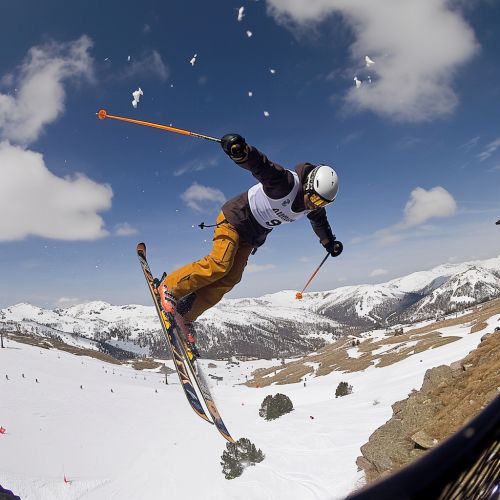Freestyle skiing
Overview
Freestyle skiing is a type of alpine skiing that combines speed, showmanship, and the ability to perform aerial manoeuvres. It evolved from cross-country skiing in the 1930s and became an official Winter Olympics sport in 1988. Freestyle skiing includes several disciplines, each with its own unique set of rules, techniques, and equipment.


History
Freestyle skiing originated in the 1930s when Norwegian skiers began performing acrobatics during cross-country training. In the 1960s, this style of skiing gained popularity in the United States, where it was known as "hot-dogging". The first World Cup series for freestyle was organized by the International Ski Federation (FIS) in 1979. The sport was included in the Winter Olympics for the first time in 1988, with the mogul discipline. Aerials were added in 1994, followed by ski cross in 2010, and halfpipe and slopestyle in 2014.
Disciplines
Freestyle skiing includes several disciplines, each requiring different skills and techniques.
Moguls
Moguls is a discipline that involves skiing down a steep, heavily moguled course, with two jumps for aerial manoeuvres. Skiers are judged on their speed, turns, and jumps.
Aerials
In the aerials discipline, skiers ski off 2-4 metre jumps, that propel them up to 6 metres in the air (which can be up to 20 metres above the ground because the landing hill is steeply pitched). Once in the air, skiers perform flips and twists before landing.
Ski Cross
Ski cross is a timed racing event that uses a naturally undulating course and features jumps, waves and banked turns. It is the only freestyle skiing discipline that does not include a form of judging as a part of the competition.
Halfpipe
The halfpipe event involves a course that is cut in half longitudinally. Skiers perform tricks while going from one side to the other and while in the air above the sides of the course.
Slopestyle
Slopestyle is a winter sport in which athletes ski down a course including a variety of obstacles including rails, jumps, and other terrain park features. Points are scored for amplitude, originality and quality of tricks.
Equipment
Freestyle skiing requires specialized equipment, including skis, boots, bindings, poles, and helmets. The type of equipment used depends on the discipline. For example, mogul skis are generally shorter with a narrower waist to facilitate quick turns. Aerial skis are similar to those used in alpine skiing, and ski cross competitors often use a slightly shorter version of the downhill ski, with a higher tip and tail for better float and balance.
Techniques
Freestyle skiing involves a variety of techniques, including carving, jumping, flipping, and spinning. These techniques are often combined in a single run. For example, a skier might carve down the slope, perform a flip off a jump, then spin in mid-air before landing.
Training and Safety
Training for freestyle skiing involves improving strength, flexibility, and balance. Skiers also need to develop a good sense of timing and coordination to perform aerial manoeuvres. Safety is a major concern in freestyle skiing due to the risk of injury from falls or collisions. Skiers are required to wear helmets and are often advised to use other protective gear such as knee pads and spine protectors.
Competitions
Freestyle skiing competitions are held at local, national, and international levels. The most prestigious competition is the Winter Olympics, where medals are awarded in each discipline. Other major competitions include the FIS Freestyle Ski World Cup and the FIS Freestyle World Ski Championships.
